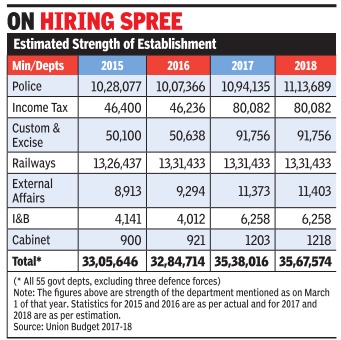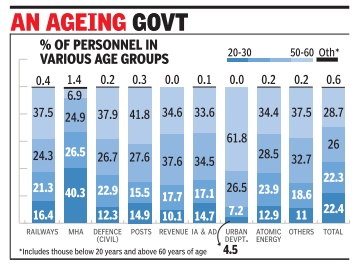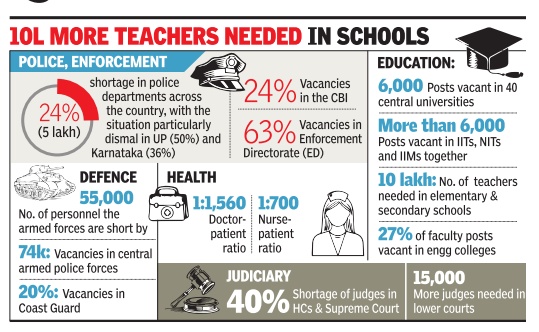Government servants/ employees: India (statistics)
m (Pdewan moved page Government servants: India (statistics) to Government servants/ employees: India (statistics) without leaving a redirect) |
(→Vacancies) |
||
| Line 135: | Line 135: | ||
[[File: Vacancies in the government in 2017.jpg| Vacancies in the government in 2017; [http://epaperbeta.timesofindia.com/Gallery.aspx?id=17_04_2017_011_013_018&type=P&artUrl=A-population-of-121-crore-but-India-reeling-17042017011013&eid=31808 The Times of India], April 17, 2017|frame|500px]] | [[File: Vacancies in the government in 2017.jpg| Vacancies in the government in 2017; [http://epaperbeta.timesofindia.com/Gallery.aspx?id=17_04_2017_011_013_018&type=P&artUrl=A-population-of-121-crore-but-India-reeling-17042017011013&eid=31808 The Times of India], April 17, 2017|frame|500px]] | ||
| + | |||
| + | ==2017: 4.2 lakh posts vacant in central govt== | ||
| + | [http://epaperbeta.timesofindia.com/Article.aspx?eid=31808&articlexml=Over-42-lakh-posts-vacant-in-central-govt-21072017015030 `Over 4.2 lakh posts vacant in central govt'|Jul 21 2017 : The Times of India (Delhi)] | ||
| + | |||
| + | Over 4.2 lakh posts are vacant in various central government departments, minister of state for personnel Jitendra Singh informed the Rajya Sabha on Thursday . Out of the total sanctioned strength of 36,49,468, the number of vacant posts in various ministries and departments is 4,20,547, he said. | ||
| + | |||
| + | The minister said this number is according to the annual report on pay and allowances of central government civilian employees (2015-16) as on March 1, 2015. | ||
Revision as of 11:59, 16 September 2017

This is a collection of articles archived for the excellence of their content. |
Contents |
Salaries
How government salaries are determined
The Times of India, Nov 23 2015
Equity important basis in fixing pay of govt staff
What is a pay commission?
From time to time, the Centre appoints pay commissions for examining various aspects of the compensation package of central government employees and recommend appropriate pay revisions. So far, seven central pay commissions have been appointed. The first was constituted in 1946, followed by commissions appointed in 1957, 1970, 1983, 1994, 2006 and 2014. These commissions are the successors of Royal commissions set up during the British raj. The gap between two pay commissions has been about a dozen years, but the last pay commission was appointed within a space of eight years.
What factors are examined in fixing salaries of government employees?
The seventh pay commission report states that the salaries of government employees should be enough to motivate them to work as well as retain them in government service as the recruitment and training process of new employees is an expensive affair. Another important basis, is equity or equal pay for equal work.
How is the minimum salary fixed?
The estimation of minimum pay in government is the first step towards building a new pay structure. It is fixed by considering the recommendations of the 15th Labour Conference held in 1957. The need-based wages are fixed to cover all the needs of a worker's family.One key measure is food requirements as specified by the recommendations of Dr Wallace Akroyd's formula providing a minimum of 2,700 calories and a specified quanitity of protein, fat and so on. The normative family is taken to consist of a spouse and two children below the age of 14. With the husband assigned one unit, wife 0.8 units and the two children 0.6 units each, the minimum wage needs to be enough to provide for three consumption units. It also keeps in mind the 1991 judgment of the Supreme Court asking for providing for education, medical expenses, recreation, festivals and ceremonies. Based on these criteria, the minimum wage fixed by the seventh pay commission is Rs 18,000.
How are higher level salaries fixed?
The pay matrix has two dimensions hor izontal and vertical.
There are 18 horizon tal levels for starting points in various government jobs and then there are verti cal ranges of pay progression for each of these levels.An employee joins at a particular level and progresses within the level as per the vertical range. The movement is usually on an annual basis, based on annual increments till the time of their next promotion. Different compensations are fixed for all these stages. In the first pay commission, there was a huge difference between the highest and the lowest paid government employees. For instance in 1948, the salary of the highest paid government official was Rs 2,000 which was 37 times higher than the Rs 55 paid to the lowest earning employee. The ratio was progressively reduced to reach 10.2 times by the fifth pay commission. In the seventh pay commission stands at 13.9.
2000-2014: Numbers and salary bill
Jan 17 2015
1,571 nursery seats for spl kids
Shreya Roychowdhury
As per the Directorate of Education’s records, there are at least 229 schools in Delhi that are capable of teaching students with some form of disability or the other. In the schools that have disclosed this information to DoE, there are over 1,571 nursery seats for children under the ‘special needs’ category—some schools are exclusively for disabled children, the rest are mainstream ones. The DoE has uploaded data on seats, category of disability the schools can handle and fees—which it collected from schools last year—on its website for applicants to use as reference.
Both the National Progressive Schools’ Conference and the Action Committee for Unaided Recognized Private schools have mentioned children with special needs in their suggested guidelines.
While few schools have mentioned disabled children in their nursery admission policy to begin with, even at those that have, reservation for this category has been implemented differently. At some, seats for this group are outside the 25% EWS-DG (economically weaker section-disadvantaged groups) category. At Springdales, Pusa Road, for instance, there are three seats for disabled candidates that aren’t part of the 25% EWS quota. “We normally get many applications from this group every year, over 50,” says principal Ameeta Mulla Wattal.
Some schools have carved a 3% reservation out of the 25% EWS-DG one as children with special needs (or CWSN) form one of the “disadvantaged groups”; this was recommended in the Action Committee guidelines as well.
Lawyer-activist Khagesh Jha, however, points out that “the Kendriya Vidyalayas had done the same thing but that guideline was quashed by the high court.” “Schools seem very confused on reserving of seats,” says Jha.
Number of central employees: Estimates
2015
The Times of India, November 20, 2015

No. of govt employees? Nobody knows
Exactly how many employees does the Central government have? The report of the Sev enth Pay Commission seems to suggest that nobody is quite sure.The report validated data on personnel received from the various ministries by comparing it with the data from two sources, the expenditure budget of the finance ministry and a census of government employees prepared by the labour ministry's Directorate General of Employment and Training (DGET). It found glaring inconsistencies in the two in some ministries. The most startling difference, the report points out is in the case of the civil employees of the defence ministry.
While the expenditure budget puts their number at just under 34,500, the DGET places it at nearly 3.8 lakh and the data obtained by the commission at almost 4 lakh. There are also huge differ ences in the figures for the postal department, the foreign ministry and the commerce ministry (see graphic).
In general, the commission found that the DGET data was closer to the numbers obtained by the commission though dated, while the expenditure budget numbers were substantially different. The report, therefore, calls for standardization of data on an IT platform to ensure its integ rity and availability of consistent data.
The same chapter in the report makes an interesting comparison with the strength of the federal government in the United States to point out that while the US has 668 federal employees per lakh of its population, India has only 139 per lakh, thereby bringing into question the notion that we have an outsized government.
It also makes the point that like in the US, federal government employment in India (excluding the Railways and Posts) is concentrated in a few departments, only more so.
In the US, the defence department accounts for about 34% of the federal personnel and the departments of veteran affairs, homeland security and the treasury between them another 29%.In India, the home ministry accounts for 55%, defence civilians 22% and revenue 5%.
The foreign ministry had the highest per capita expenditure on pay and allowances for personnel at Rs 34.95 lakh in 2012-13, while the home ministry's figure was a mere Rs 2.97 lakh.
One obvious reason was that Group A officers form a much higher proportion of MEA personnel than in most other departments barring some like space, civil aviation, IT and renewable energy . The allowances for postings abroad would clearly be another factor.
2016-17

figures for 2017, 18 are only estimates.
The Times of India
As of March 2016, the central government had 32.84 lakh staff across 55 departments and ministries, including 13.31 lakh in railways, but excluding defence forces.
Police forces (central paramilitary and Delhi Police) strength: 10.07 lakh
The income tax department, the agency involved in the drive against black money post-demonetisation: existing strength of 46,000.
Customs and excise department, which implement the ambitious goods and services tax regime current strength: 50,600+ . Railways, the single largest employer (13.31 lakh) other than defence.
MEA/ foreign ministry employees: 9,294 in 2016.
The I&B ministry sanctioned strength: 4,012.
The cabinet secretariat: 921 in March 2017.
Retirements due between 2015-2025
The Times of India, November 21, 2015

Several depts face surge in retirements in 10 yrs
Surojit Gupta
The age profile of government servants analysed by the Seventh Pay Commission shows that several government departments will face a surge in the number of employees retiring in ten years. The panel reviewed data for all ministriesdepartments of employees in the 50-60 years age bracket. Of 33.02 lakh employees -as on January 1, 2014 -9.48 lakh, (about 29% of personnel) were between 50 and 60.
This is contrary to the perception that the government is bloated and there's need to do away with departments that have outlived their utility . The government, officials said, must take note of this and do succession planning for smooth functioning of these departments.
The data shows an unusually large percentage of personnel in the 50-60 years age group in certain ministriesdepartments.
In the textile ministry it is as high as 75%, 64% in coal, 62% in urban development, 60% in petroleum and natural gas, 57% in science and technology, 56% in heavy industry, 52% in new and renewable energy, 51% in AYUSH and 50% in power.
“This is a ready pointer to the number of retirements that would take place in the next 10 years,“ the Seventh Pay Commission report said. Officials said either departments that face high retirements should be merged or an action plan be put in place to ensure smooth transition.
“The commission notes that losing experienced, high-level personnel entails unquantifiable costs as new recruits will require training and on the job skills.
“At the same time it presents ministries, departments the opportunity to align their personnel re quirement with their current and future challenges,“ the report said.
Personnel in the 20-30 years and 30-40 years brackets is substantial among personnel in the home ministry .Larger departments such as the railways, posts and Indian audit & accounts department have larger percentages in the 20-30 years group compared to other ministries.
The commission noted a discernible pattern in comparatively smaller departments. A review of all ministriesde par tments with persons in positions (PIP) less than 500 was undertaken.
The findings pointed to the fact that in most of these ministries departments the percentage of personnel between 20 and 30 was significantly lower than in the larger departments.
Vacancies
2017
See graphic.

2017: 4.2 lakh posts vacant in central govt
`Over 4.2 lakh posts vacant in central govt'|Jul 21 2017 : The Times of India (Delhi)
Over 4.2 lakh posts are vacant in various central government departments, minister of state for personnel Jitendra Singh informed the Rajya Sabha on Thursday . Out of the total sanctioned strength of 36,49,468, the number of vacant posts in various ministries and departments is 4,20,547, he said.
The minister said this number is according to the annual report on pay and allowances of central government civilian employees (2015-16) as on March 1, 2015.
